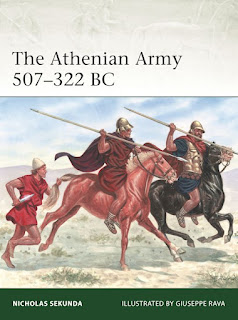There have been many general studies of the armies of this period, but now the Athenian Army has a stand-alone Osprey by Nick Sekunda. Fortunately, there are surviving texts about ancient Athens and lots of archaeological evidence. However, as the author highlights, that doesn't mean there are no differences in interpretation.
The book starts with Cleisthenes's reforms in 507 and a new 'democratic' system of government. However, it was a limited form of democracy as Athenian society was a slave-owning society and economy. Consequently, its citizens could be released to perform military service without the economy collapsing. This was tested early on by the Persian Wars, including the battles of Marathon and Platea.
This book's strength is in the army itself. It starts with the practically universal liability for military service, with registration from 17 and the oath-taking. Service was limited to the boundaries of Attica until age 20, an obligation that remained until age 50, then only within the borders again until 60. The citizen of sufficient wealth would serve as a hoplite, providing their own equipment accompanied by a psilos, which usually meant an attendant (often a slave) rather than a lightly armed combatant.
The evidence for Athenian cavalry is limited, but they appeared to be recruited from the wealthier citizens. They originally numbered no more than 300, although this was expanded to 1,000 during Pericles's reforms. They provided their own horses and equipment but were paid a fodder allowance and a grant to replace horses lost on campaigns. There was also a 200-strong unit of horse archers.
At the start of the Peloponnesian War, the Athenian army's strength was 13,000 citizen hoplites of military age with 16,000 ephēboi (old and young), limited to home service. There were 1,200 cavalry, including the 200 horse-archers and 1,600 foot-archers. The Athenian fleet was one of its strongest assets, with 300 seaworthy triremes. The triremes would have required over 50,000 oarsmen if fully manned, which meant the Athenians depended on foreigners to crew their navy. The fighting troops on board included hoplites, archers and peltasts.
The organisation and equipment did not change hugely during this period. However, the author shows how it evolved in response to losses, economic pressures and the different campaigns. For example, at the end of this period, wealthier citizens would donate equipment to allow poorer citizens to fight. The hoplite shield was particularly expensive.
As you would expect in an Osprey, there are excellent colour plates and other illustrations for all the troop types. These are situated close to the relevant text in the Elite series, which I prefer, although it takes a bit of getting used to.
 |
| Some of my 28mm Athenian hoplites. |

I suspect I may well flick through the book, but probably won’t purchase it (the prime reason being that I prefer to keep my hoplite miniatures quite generic, rather than any specific city/state).
ReplyDeleteCheers,
Geoff
Yes, I suspect most do. Some of the shield patterns were different, but otherwise not a great deal of difference. The Osprey Warrior book was generic as well.
Delete